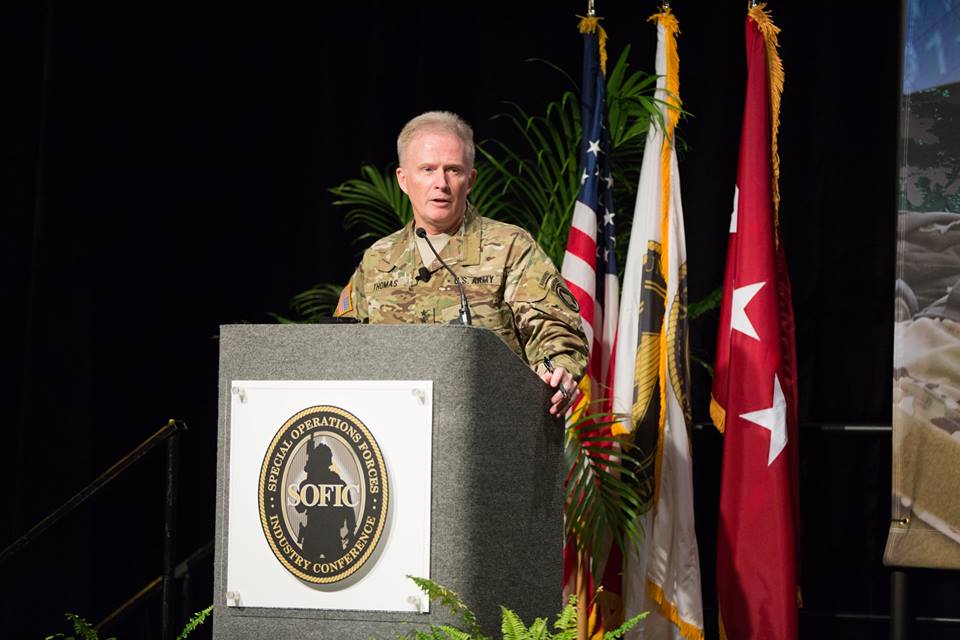Last month, the new Commander of the U.S. Special Operations Command, Gen. Raymond “Tony” Thomas, spoke at the National Defense Industrial Association’s Special Operations Forces Industry Conference (SOFIC), and laid out his vision for America’s special operations forces.
Based on his remarks at SOFIC, it’s apparent that Gen. Thomas is focused on changing the reactive nature of our special forces and making these elite groups more proactive. He appears committed to strategically placing personnel and capability in locations that will allow them to impact situations before the shooting starts, “left of boom”, if you will.
According to the General, “…being there ahead of time, having relationships there ahead of time, identifying problems before they become crises, developing that partner capacity, prior, not after, a response. We are too often on the other side of that.”
To become more proactive, the way in which the Special Operations Command operates will have to change at the fundamental level. Instead of being kinetic and dispatching to areas of conflict when needed, they would – instead – have smaller groups of special forces soldiers deployed in more locations and for longer durations.
Also, to become less reactionary and move “left of boom,” they’ll require an incredible amount of intelligence and information. Only through the aggregation, sharing and analysis of intelligence can the Special Operations Command truly identify crises before they occur and put plans in place to avoid them.
Luckily, this increased amount of intelligence is increasingly becoming available. The military has worked exhaustingly on the creation of new sensors that can gather the intelligence needed to identify trends and relationships and identify issues before they occur. This intelligence comes from many different places, some of which include HD video and photos from unmanned aerial vehicles (UAVs), unstructured data gleamed from social networks and data from cellular and wireless networks.
However, data is useless if it can’t be analyzed, and the more data that’s available, the larger the task of analyzing it. With smaller teams in the field, distributed more widely across the globe, special forces simply won’t have the manpower in theater to aggregate and analyze the mountains of data that they’re generating. It’s going to have to be aggregated in theater, and then moved to another location where large teams of analysts and leaders can analyze, process and use it to impact decision making. This is where the military has a challenge to overcome.
The sheer amount of data, the large number of sensors and the size of the HD video and photos being aggregated and sent for analysis creates an immense bandwidth demand for transmitting information and data to and from theater. And, in many cases, SATCOM networks are the only way to deliver information since terrestrial networks simply aren’t available.
New advances in COMSATCOM are ground-breaking, with today’s solutions offering low latency, high-throughput connectivity that the military needs to deliver this intelligence from the field to the places where it can be shared, analyzed and used to make informed military decisions. One of these new advances in COMSATCOM is the emergence of Medium Earth Orbit (MEO) satellite constellations. These satellites are approximately half the distance from the Earth as traditional geosynchronous (GEO) satellites, which dramatically reduces latency and enables fiber-like connectivity This is exceedingly important to the military user that wants to aggregate, share and analyze the kind of data that can truly improve situational awareness, impact decision making and enable it to become more proactive – especially today’s HD and UHD video.
As General Thomas discussed, the future of America’s special forces is more proactive – operating “left of the boom” and responding to crises before they even become crises. But to do that, the military needs actionable intelligence – and lots of it – to give them the foresight to identify and characterize issues before they arise. MEO satellite constellations like O3b offer a solution to the “Big Data” dilemma facing the military today.
Additional Resources on MEO & GEO constellations:
- GEO & MEO White Paper
- White Paper on “Fiber Like” Satellite Communications for U.S. Government Applications
- Video: Fiber in the Sky
*Photo courtesy of the National Defense Industrial Association (NDIA).
